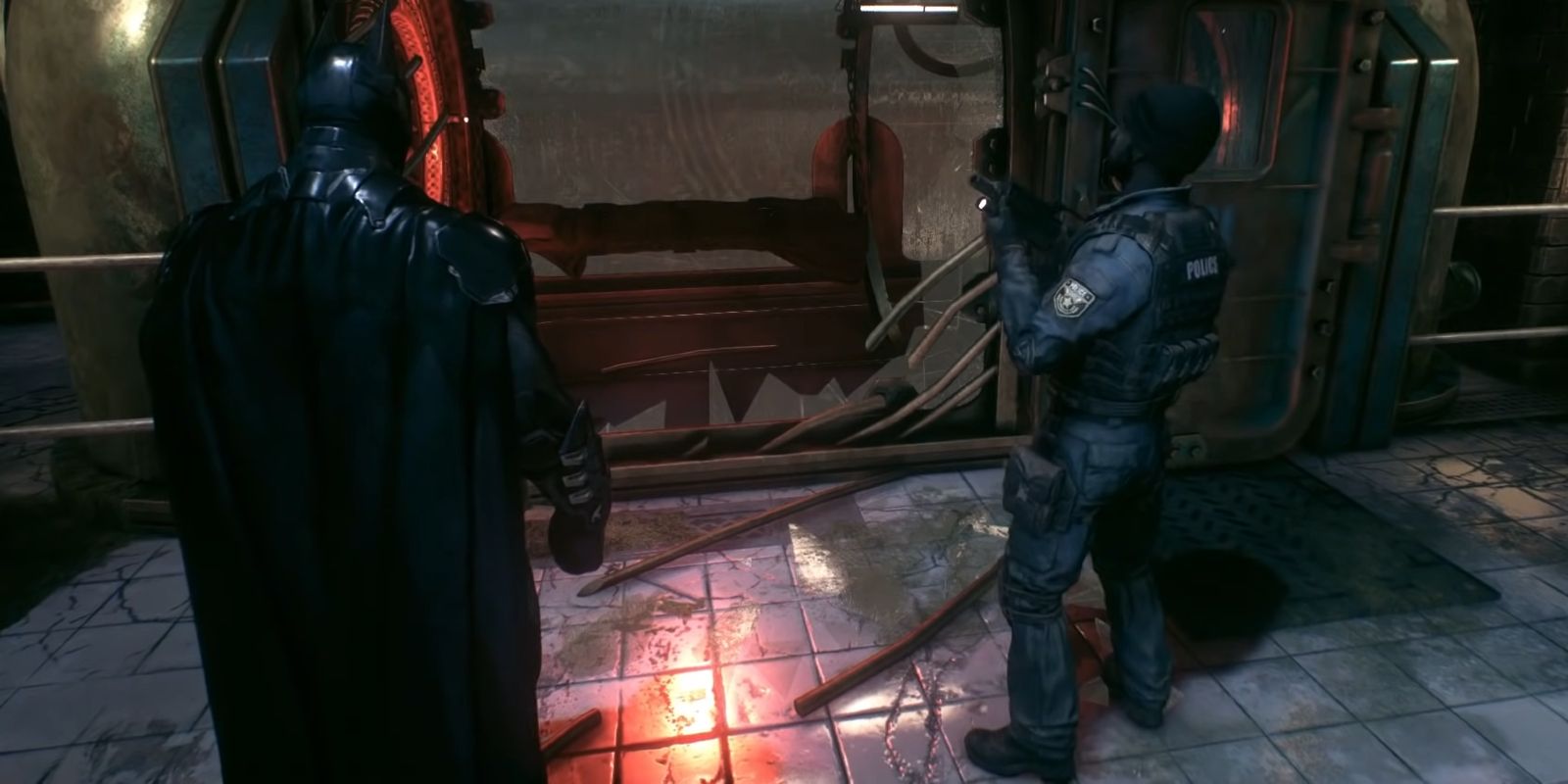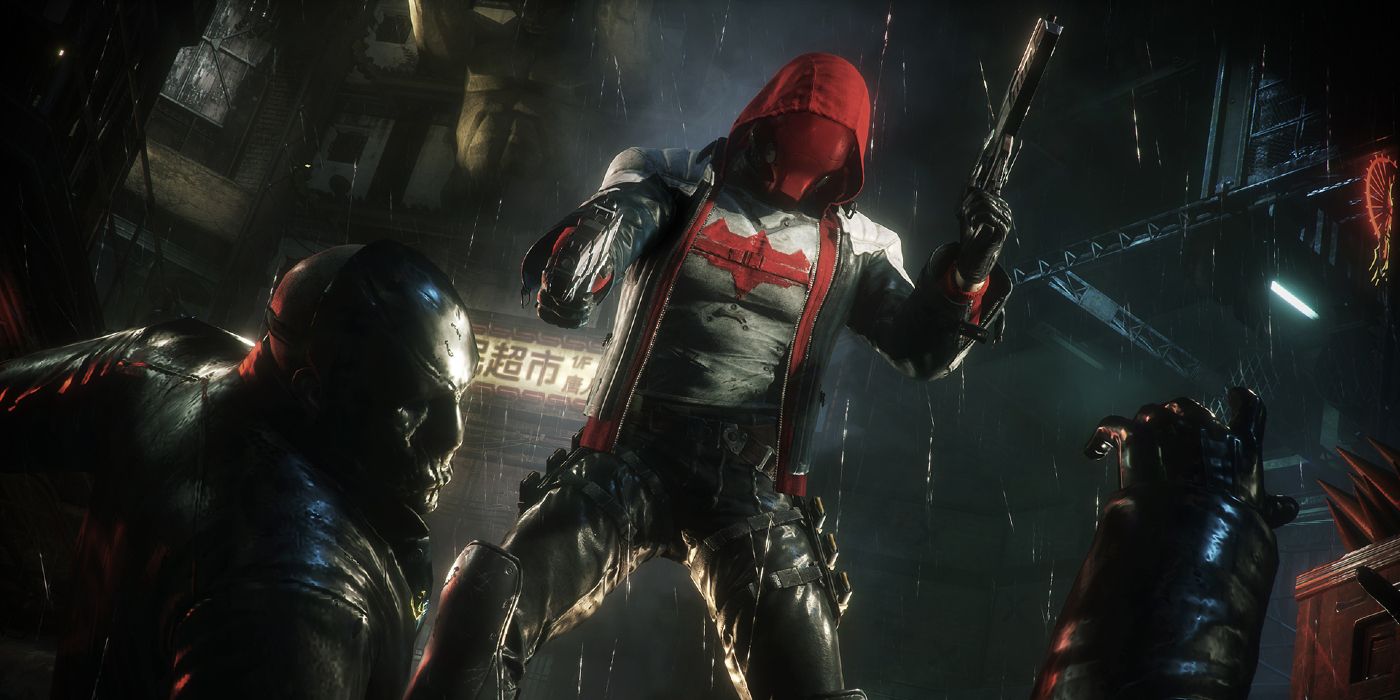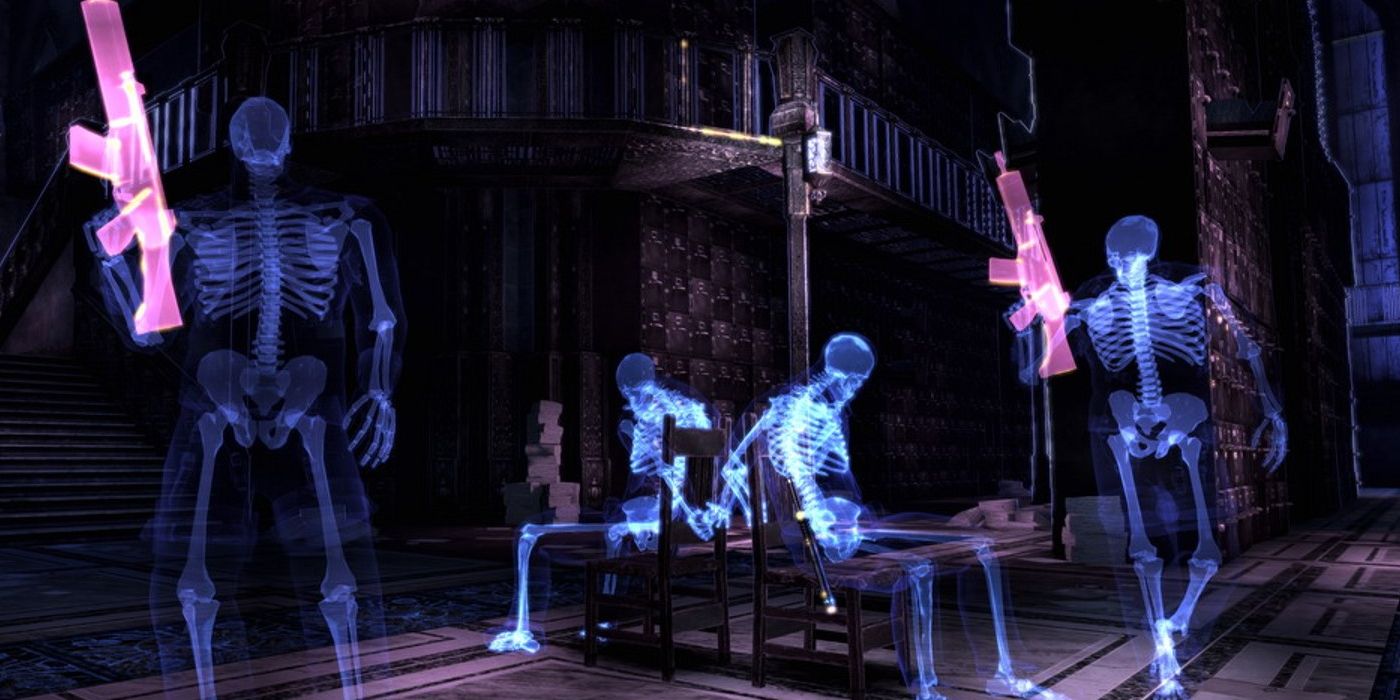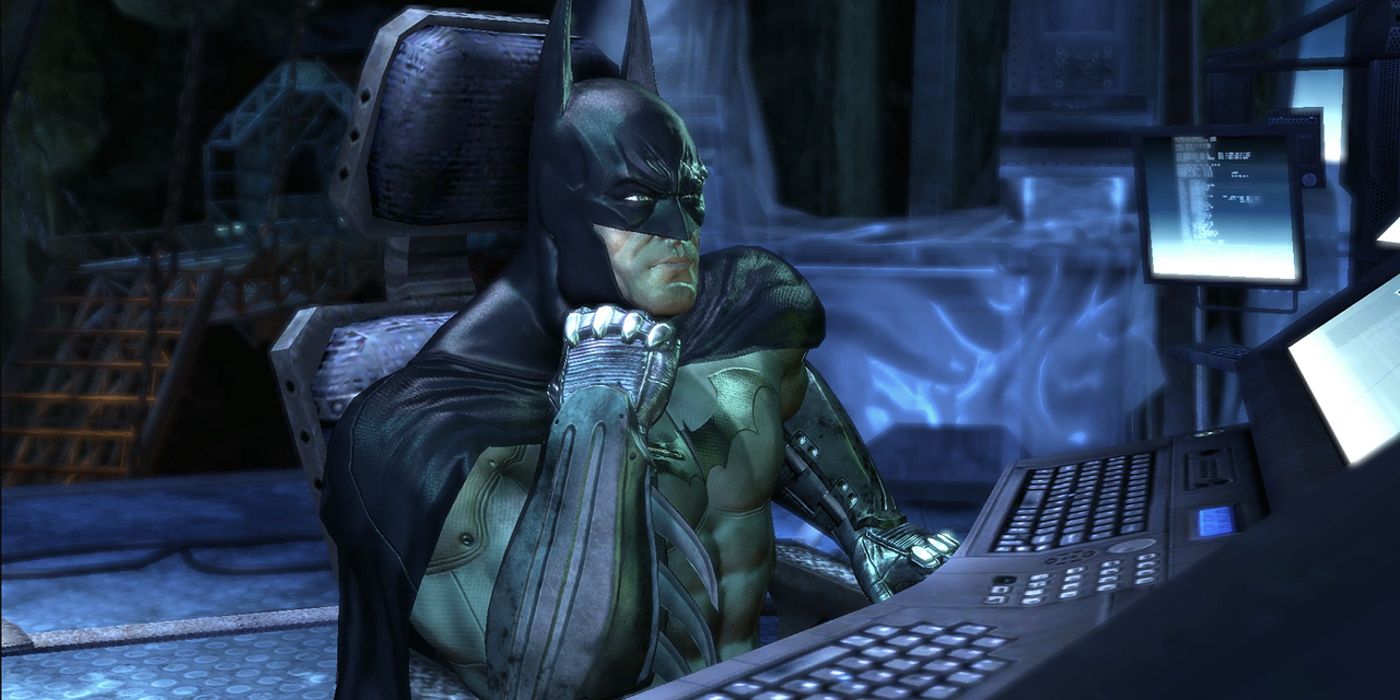Batman is one of the most famous heroes in modern-day culture, having appeared in countless games, TV shows, and movies, but the Dark Knight commits many crimes in Batman: Arkham Knight. Though Batman and other members of the Justice League strive to save their world from lowlifes, criminals, and supervillains, they inadvertently commit many crimes themselves. Despite his lack of superpowers, Batman is one of the most destructive superheroes in DC, especially when players control his actions during Batman: Arkham Knight's campaign and side missions.
Batman: Arkham Knight is the finale to the Batman Arkham games, detailing the story of how Batman "died" protecting Gotham City. The story begins the night after Scarecrow's deadly gas attack at a local diner, which causes the inhabitants of Gotham City to evacuate. Accompanied by the Arkham Knight and his militia, Scarecrow and the Gotham Rogues carry out their plan to finally defeat the Caped Crusader. Despite Batman's pure intentions, the Dark Knight makes some difficult choices that make him as much of a criminal as the goons and soldiers throughout Arkham Knight.
Batman has always been the topic of debate, with his non-lethal methods enabling violent criminals like the Joker to wander free repeatedly. Though Batman's story emphasizes improving Gotham City as the Dark Knight and Bruce Wayne, he's not completely innocent. The Batman: White Knight comic series explores this side of Batman, where he confronts his flawed crime-fighting method. However, there's no way for Bruce to face his crimes in Batman: Arkham Knight until the game's explosive ending. Though villains like Scarecrow, Deathstroke, and the Arkham Knight are worse criminals than Batman, Gotham's savior commits his fair share of crimes throughout Batman: Arkham Knight's story.
Batman's Crimes In Arkham Knight: Vigilantism
Batman's most obvious crime is vigilantism. Though Gotham City's Police Department consistently fails to protect and serve its citizens, it's still illegal to dress like a bat and fight crime. The unfortunate truth of the justice system is that bypassing its functionsmakes the 'hero' nearly as flawed as the villains. As Scarecrow points out several times throughout the Arkham Knight campaign, Bruce Wayne crafted the Batman myth to replace one broken system with another. After the vigilante is unmasked, Batman's legend 'dies,' and crime continues to roam freely through Gotham City. Though Bruce Wayne appears to have continued his crime-fighting career and vigilantism, his actions are still a crime and may leave many speculating whether Batman's methods are a better alternative. For example, suppose Batman had refused to leave his home or worked on evacuating the remaining populace within Gotham instead. In that case, it's likely Bruce Wayne's secret identity in Arkham Knight would never have been revealed, and Scarecrow's plan would have failed nonetheless.
Batman's Crimes In Arkham Knight: Assault, Torture, & Battery
In fighting games, players regularly guide their characters to mercilessly defeat the many enemies set against them. Batman: Arkham Knight's combat system and mechanics are no exception, creating Batman's most brutal version in recent entertainment media. While some of the technology Bruce employs during his combat bouts seem particularly cruel, his interrogation methods are undeniably torture. The Arkham Knight's Militia members frequently have their bones broken, heads crushed beneath tires, bodies slammed against brick walls, and more. While some may argue these interrogation and combat methods are necessary for the greater good, Batman's track record is particularly abysmal when considering the countless assault, torture, and battery charges he's accrued throughout his career as Batman and during Arkham Knight.
Batman's Crimes In Arkham Knight: Breaking & Entering
While players spend most of their time in Batman: Arkham Knight's open-world flying, grappling, and exploring outside different buildings, Batman frequently explores the interior of buildings for specific missions. Though players can't explore every building, most buildings are private property or locked tightly. His reasons for breaking into these locations vary but also result in additional crimes against the inhabitants of Gotham City (and the assets hidden within their locked buildings or homes). Batman frequently destroys walls, tears doors off hinges, or shatters the windows of private buildings to beat up thugs, extract secure information from databases, plant bugs, or receive intel from one of his many conspirators.
Batman's Crimes In Arkham Knight: Operation Of Unlicensed Vehicle & Vehicle Abandonment
Being Batman comes with its pros and cons, but it's unlikely the Dark Knight ever waited in line to register the Batmobile at the DMV. Though Scarecrow's threat empties Gotham's streets in Batman: Arkham Knight, it's still a crime to operate the licensed vehicle on what were once public streets. While it's unlikely Arkham Knight's other thugs driving the streets have licensed their many tanks and cars, the Batmobile is a regular offender. No matter how cool the car is, Batman hasn't paid his dues to Gotham's public offices, and prosecutors could likely convict him of illegally operating it on public streets and within city limits. Additionally, throughout the open-world roaming game, it's unlikely players are taking the time to park the Batmobile in designated spaces. Though Batman: Arkham Knight takes place within the span of a night, players are likely to leave the Batmobile stranded on the other side of the city for days in real-time. This extended period of an idling, abandoned tank-car with built-in safety measures counts as vehicle abandonment, another crime Batman commits during Batman: Arkham Knight.
Batman's Crimes In Arkham Knight: Reckless Driving And Speeding
On the topic of the Batmobile, players are unlikely to follow the rules of the road with as much rigidity as in real life. The Batmobile in Batman: Arkham Knight is a frequently used transportation method and tool throughout the game's massive open world and during several puzzles (including Riddler's frustrating trophies). However, it can be difficult for players to stay on the road when battling tanks and thugs, and it's unlikely the vehicle remains under the speed limit even in its lowest settings. Veering into the wrong lane, crashing into enemy vehicles and buildings, or wreaking wanton destruction throughout Gotham City are all actions Batman is guilty of that constitute reckless driving. The speed at which players can cross the entire city also violates many speed limits, even though there aren't many signs depicting the limit within Gotham.
Batman's Crimes In Arkham Knight: Destruction Of Property & Trespassing
Perhaps the most common crime Batman commits during Batman: Arkham Knight is destroying property and trespassing. However, the GCPD has more significant concerns than keeping the Dark Knight off rooftops and defending public or private property. Some of the many locations destroyed during Batman's antics in Batman: Arkham Knight is Gotham's sewers, which suffer extreme damage during a violent struggle against the Arkham Knight. Additionally, Batman must destroy countless other buildings, bridges, and infrastructure (like fire hydrants) to progress throughout the game. In doing so, Batman is trespassing on locations explicitly restricted to the public like construction sites, active crime scenes, and Gotham's many rooftops. While Bruce may be better equipped than Gotham's police force to handle general surveillance and crime scene investigation than the police, he would still be charged with these crimes at the end of Arkham Knight.
Batman's Crimes In Arkham Knight: Unlawful Interception
From the moment players enter Batman: Arkham Knight in the Batsuit, Batman's surveillance equipment immediately begins picking up radio frequencies throughout the city. While it's legal for citizens to have access to equipment like HAM radios, walkie-talkies, and more, users require different certifications to use them, or the technology must be registered. Additionally, several frequencies are regarded as private and unlawful for the public to access. As a result, Batman regularly commits unlawful interception by hacking police scanners, personal communications, emails, phone calls, and more to discover the villains' plots and gather intel on Scarecrow and the Arkham Knight.
Batman's Crimes In Arkham Knight: Child Endangerment
Batman has a habit of endangering those closest to him, but perhaps his greatest crime in Batman: Arkham Knight occurs in a flashback. Though Bruce Wayne recruited many wayward orphans to his side as Robin, Jason Todd met the most unfortunate fate. Believed to have been captured and killed by the Joker, Jason Todd instead spent over a year in Arkham Asylum's hidden basement tortured by Joker and other Gotham Rogues. This experience broke him, twisting him against Batman and urging him to join Scarecrow as the Arkham Knight. Both Jason's fate and the fates of Batman's other Robins prove Bruce Wayne is guilty of child endangerment throughout his Batman career and continues to place them in danger with his obsession. Unfortunately, both Batman: Arkham Knight's Nightwing and Red Robin (Tim Drake) cannot break free from this lifestyle thanks to Bruce's form of parenting when raising them.
Batman's Crimes In Arkham Knight: Stalking
As a hero whose entire wardrobe and gimmick focus on stealth and sneak attacks, it's unsurprising that Batman is guilty of stalking Gotham's many supervillains and crooks throughout Batman: Arkham Knight. While he also participates in all-out brawls, players can shorten these confrontations significantly by embracing a stealthier approach. Watching and waiting for the perfect moment to strike could take several minutes and fits the National Institute of Justice's definition of stalking. Given Batman's dependence on intimidation, his constant threats against his Rogues and his habit of lurking around their bases and thwarting their plots technically constitutes stalking. Additionally, any low-level thug that appears in different levels can charge Batman with stalking as well.
Batman's Crimes In Arkham Knight: Unlawful Imprisonment
Batman: Arkham Knight sees Batman commit unlawful imprisonment in a surprising twist. While many enemies are dropped off at GCPD's precinct and locked up in specialized (or shared) cells, these aren't the only individuals Batman imprisons during his last night in Gotham. Batman: Arkham Knight's Robin (aka Tim Drake) and the various citizens infected with Joker's blood are locked in specialized cells away from GCPD. When Robin insists Batman lock himself up to prevent him from losing control, Bruce shoves the young vigilante into a cell of his own and leaves him there for the rest of the night. While Harley Quinn eventually frees some of these characters, Batman cannot imprison citizens (even those with warrants out for their arrest).
Batman's Crimes In Arkham Knight: Aiding and Abetting
Despite Batman's ongoing war against crime in Gotham City, a few villains in Batman: Arkham Knight escape his justice with ease. Catwoman is a frequent accomplish to Batman's schemes, despite having a hefty rap sheet and suffering imprisonment at the hands of Hugo Strange. Additionally, once the Arkham Knight is unmasked and Bruce discovers his true identity, he does not attempt to apprehend him like Gotham's other criminals. Batman Arkham's Red Hood (formerly the Arkham Knight) and Catwoman both escape the police thanks to Batman's mercy, which would, unfortunately, make him guilty of aiding and abetting. Especially considering Red Hood's illegal activities continue well after Batman's apparent 'demise.'
Batman's Crimes In Arkham Knight: Conspiracy
As previously stated, Batman has a network of supporters that assist in his crime-fighting activities. These actions and cooperative plots to commit vigilantism, assault, torture, and more make him guilty of conspiracy. This crime involves the plotting of two or more individuals to commit illegal activities or cause harm. Given Batman's myriad of violent activities within Gotham City, Batman: Arkham Knight's story sees Batman regularly engage in a conspiracy in the company of the supervillains he attempts to defeat. While his foes have had far longer to prepare their villainous plots, Batman Arkham's Oracle, Alfred, Robin, and Nightwing all assist Batman in his efforts to control Gotham City through vigilantism. These acts result in hospitalized criminals and more illegal activities, proving every member of the Batfamily is guilty of conspiracy.
Batman's Crimes In Arkham Knight: Illegal Searches And Seizures
Given the state of Gotham City in Batman: Arkham Knight, Batman can't acquire any warrants for his investigations during the night. Additionally, he's not a licensed law officer, giving him no right to search or seize any evidence (even with reasonable cause). Batman's Detective Vision often shortens the searches by a significant period of time, leading players directly to the necessary proof and allowing Batman to solve his cases far swifter than the usual GCPD officer. While Batman's methods are efficient, his actions are still illegal without following due process of law.
Batman's Crimes In Arkham Knight: Tampering With Evidence
Though Batman's reputation as the World's Greatest Detective gives him some leeway when assisting GCPD with their investigations, he often disrupts the crime scenes he investigates by setting off traps, brawling with other foes, or removing crucial evidence to the case. While it's helpful for him to find the solutions and provide the evidence to the police, it's unlikely for many convictions to stick given the unlawful methods of arrest, evidence gathering, etc. This means that no matter how many goons, thugs, or supervillains Batman delivers to GCPD, their prison acts as a revolving door for the scum Batman claims to discourage. Tampering with evidence does no one in GCPD or Gotham City any good, but there's no way to avoid it in Batman: Arkham Knight's gameplay.
Batman's Crimes In Arkham Knight: Illegal Construction
Batman's Batcave exists beneath Wayne Manor thanks to natural cave systems, but Bruce Wayne has participated in independent construction for the raised pathways and platforms that make it habitable. While few people know of the Batcave's existence, it's unlikely Bruce Wayne secured permits to build Batman: Arkham Knight's impressive underground fortress. While this is the most passive crime Batman commits during Arkham Knight and pales in comparison to others, its existence is evidence of Bruce Wayne's habits to commit crimes passively over his years of vigilantism. Not every crime is as 'serious' as those he performs in the Batsuit, and not all result in broken bones or trampled civil rights.
Despite Batman's crimes, it's undeniable that his actions in Gotham City keep its inhabitants safer than they would be without the Dark Knight. His assistance with GCPD's efforts to keep criminals off the streets (for a time) and thwart villainous plots have saved countless lives. Unfortunately, Batman's intervention within the justice system proves that no official office can completely repair the shattered state in the Batman Arkham universe. Though Batman's adventures within the Batman Arkham universe appear to be over, players can replay Batman: Arkham Knight or await the release of Suicide Squad: Kill the Justice League, Batman Arkham's official sequel. Batman: Arkham Knight is available now on PC, Xbox, and PlayStation, while Suicide Squad: Kill the Justice League will be released at some point in 2022 for the same systems.
Source: National Institute Of Justice
















